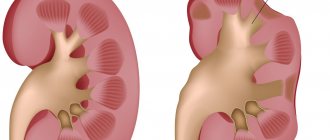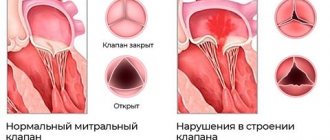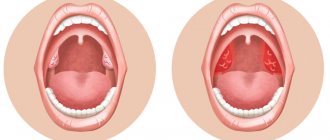Published: 09/24/2021 12:05:00 Updated: 09/24/2021
Peritonitis is an inflammatory lesion of the peritoneum, the serous membrane covering most of the internal organs and lining the walls of the abdominal cavity from the inside. In most cases, it occurs as a complication of infectious and inflammatory diseases or injuries in the chest and abdomen. The patient's condition is often severe, with intense abdominal pain, vomiting, fever and other symptoms. Treatment is aimed at combating the infectious pathogen, most often of bacterial origin, and always includes abdominal surgery.
The peritoneum performs several important functions:
- regulates the volume and composition of fluid filling the abdominal cavity;
- provides mechanical and immune protection of internal organs;
- limits the source of infection due to the formation of adhesions, preventing the spread of the pathogen throughout the body.
Its inflammation leads to disruption of vital organs and the development of adverse pathophysiological reactions that are dangerous to humans.
Causes
Typically, inflammation of the peritoneum is caused by a bacterial infection.
Often these are representatives of the normal microflora of the digestive system - enterobacteria, E. coli, Proteus, cocci, clostridia and other microorganisms. Less commonly, pathogens include gonorrhea, tuberculosis, hemolytic streptococcus or pneumococcus. Depending on the route of penetration of the pathogen into the abdominal cavity, three types of pathology are distinguished. Primary peritonitis develops when the pathogen migrates from other foci of inflammation along the bloodstream, fallopian tubes in women, or with the lymph flow. This is possible with diseases of the pelvic organs, including gynecological diseases, inflammation in the gastrointestinal tract, and infectious kidney lesions.
Secondary peritonitis is not an independent disease, but a complication of destructive and inflammatory lesions of the abdominal organs. Peritonitis can also be caused by penetrating injury to the abdominal wall or blunt trauma to the abdomen with rupture of internal organs, postoperative complications and errors during surgical interventions. Separately, it is worth noting inflammatory lesions of the peritoneum due to malignant tumors, helminthic infestation, granulomatous and rheumatoid processes in the body.
Tertiary peritonitis occurs two days after removal of the focus of secondary peritonitis. The reason for its appearance is that the patient’s body was unable to form an adequate response to the infectious process.
Course of the disease (pathogenesis)
The peritoneum becomes inflamed when an infection enters it. This leads to disruption of metabolic processes in the body, decreased blood circulation and disruption of the acid-base balance. Blood clots poorly, and body temperature rises. The muscles of the abdominal wall are in constant tension.
According to the time of occurrence and danger, three phases of peritonitis are distinguished. The first is the initial one, followed by the other two. As the disease progresses, the symptoms intensify, the pain increases, and the person becomes worse and worse. Lack of timely treatment can lead to death within 2–3 days.
First phase
This is the reactive phase of the disease, it includes the first 24 hours from the onset of local symptoms. The disease begins to manifest itself with regular abdominal pain, fever, vomiting and severely tense abdominal muscles.
This is the best phase for treatment. If the operation is performed on time, doctors talk about a 90% chance of saving the patient.
Second phase
The second or toxic phase of the disease occurs 24-72 hours after the onset of symptoms. Intoxication of the body occurs. A person becomes pale due to a disturbance in the amount of circulating blood. The motility of the gastrointestinal tract is severely impaired (intestinal paresis): it is difficult for the intestines to absorb liquids and gases, it stretches, and flatulence appears. The acidity of the body is greatly increased (acidosis). The intestinal microflora goes beyond its boundaries, resulting in microbes and toxins entering the blood and abdominal cavity.
Third phase
The phase of severe intoxication or the terminal phase, which occurs after 72 hours. Characterized by toxic shock and irreversible changes in the body.
Organs are no longer able to ensure the viability of the body (multiple organ failure). Bacteria enter the bloodstream (bacteremia). Treatment in this phase is much less effective and the mortality rate is higher.
Peritonitis with sepsis
Since untreated peritonitis leads to sepsis (infection of the blood and tissues), the medical community also distinguishes four phases of peritonitis associated with this process:
- absence of sepsis;
- sepsis;
- severe sepsis;
- septic (infectious-toxic) shock. The patient goes into shock due to critically low blood pressure, and organs begin to fail due to infection and insufficient blood supply.
Peritonitis in children
The infection develops faster than in adults. Often the onset of the disease remains unrecorded: a small child is simply not able to tell what and where it hurts. A common cause of peritonitis in children is acute appendicitis. Children with nephrotic syndrome and immunodeficiency are most susceptible to infection. Infantile peritonitis should be suspected if the child is vomiting, has a fever, has blood in the stool, or has diarrhea.
Peritonitis in adults
Peritonitis causes death in older people much more often than in young people. The reason for this may be exhaustion of the body due to the severe course of the underlying disease. The pain in this case is usually not severe, and there may be no tension in the abdominal muscles. If older people have diabetes, the infection may have no symptoms at all.
It is most difficult to recognize peritonitis in elderly people after operations on the abdominal organs. If in the preoperative period patients complain of pain, malaise, and abdominal tension, then after the operation signs of infection do not clearly appear.
Classification
Peritonitis is of the following types:
- bacterial – caused by microbial flora;
- abacterial - with aseptic or toxic-chemical inflammation of the peritoneum due to its irritation by aggressive non-infected fluids (blood, digestive enzymes and secretions of internal organs, urine);
- special forms - parasitic, rheumatoid, carcinomatous and granulomatous.
According to the course of the disease, peritonitis is divided into acute and chronic.
According to the area of the affected peritoneum, inflammation can be limited, local (with damage to 1-2 anatomical areas), diffuse (covering three or more areas) and general (with total inflammation).
In its development, the disease goes through an early phase (less than twelve hours), late (less than five days) and final (from one to three weeks from the onset of inflammation).
Prevention
If other diseases are present, such as ascites and cirrhosis, antibiotics are used to prevent infection. In primary peritonitis, when the infection is transmitted through the blood or lymph from another organ, it is extremely difficult to predict and prevent the development of the disease.
It is not for nothing that the intestine is called the second brain of a person. The gastrointestinal tract is a separate organism within a person with its own microflora and processes. If it stops its activity, the consequences will be as irreversible as with dysfunction of the brain or heart. It is important to listen for unusual symptoms, do not ignore pain, and undergo regular examination by doctors.
Symptoms
Acute peritonitis occurs in three stages, each of which has its own manifestations.
On the first day from the onset of peritonitis, in the reactive stage, a local reaction to irritation of the peritoneum is noted. Initially, pain is localized where the source of inflammation is located, and can radiate to the shoulder, under the collarbone. Subsequently, the pain spreads throughout the abdomen. To alleviate the condition, a person assumes the “embryo” position, lying with his legs pressed to his stomach. The patient is concerned about dry mouth, nausea and vomiting, and loss of appetite. The toxic stage develops between four and seventy-eight hours. Characterized by increasing intoxication up to endotoxic shock, increased general manifestations - blood pressure decreases, heart rate increases, body temperature rises and breathing problems appear. The pain is diffuse in nature, its intensity decreases, as paralysis of the nerve endings of the peritoneum begins, bloating and constipation are noted.
In the terminal stage, after seventy-two hours from the onset of inflammation of the peritoneum, a gross disruption of vital processes inside the body occurs. The symptoms of peritonitis are dominated by manifestations of paralytic intestinal obstruction - intense abdominal pain, severe vomiting that does not bring relief, and severe bloating. The patient's condition is extremely serious, facial features are sharpened, blood pressure is sharply reduced, urine does not pass, consciousness is confused, limbs acquire a bluish or yellow tint, increased sweating and other signs of multiple organ failure are characteristic.
Chronic peritonitis is characterized by “blurred” symptoms that arise as a result of prolonged intoxication and the formation of adhesions in the abdominal cavity, disrupting the functioning of internal organs.
Pathology manifests itself:
- lack of appetite and weight loss;
- increased sweating;
- persistent low-grade fever up to 37.5 °C;
- bowel dysfunction;
- periodic abdominal pain and bloating.
Adhesions and dense scar cords make it difficult to empty the hollow organs, which is accompanied by dyspeptic symptoms - nausea, vomiting, flatulence, urination and menstrual disorders.
Clinical manifestations of pathology
Symptoms vary and depend on the stage of the pathological process, as well as the cause of inflammation. The most common manifestations:
- pain in the abdominal area, which increases with movement;
- nausea;
- vomit;
- fever, chills.
During the reactive stage (the first day of development of inflammation), the main symptom is sharp pain of a constant nature. Usually a person lies on his side, bent over, and tries not to move. If the source of peritonitis is in the upper region of the peritoneum, then the pain may radiate to the back or shoulder area. When inflammation is localized in the lower part, false urge to go to the toilet, pain in the pelvis and perineum are possible.
Vomiting does not bring relief. There is a rapid pulse, more than 100 beats per minute. Blood pressure may be slightly lower. When certain intestinal diseases are complicated, there may be blood in the stool.
With increasing intoxication of the body, the toxic stage of peritonitis occurs. Symptoms are smoothed out as protective muscle tension is weakened. The pain may decrease. The so-called symptom of deathly silence is observed when peristaltic noises are not heard in the intestines. The abdomen is tense, gas and stool retention occurs.
Body temperature rises to 38-39° degrees. Consciousness becomes confused. The terminal stage begins, which is characterized by severe loss of strength, shallow breathing, and severe profuse vomiting of intestinal contents. At this stage, the risk of death without immediate medical attention increases.
Peritonitis often leads to the development of septic shock, sepsis or hepatic renal failure.
Complications
Peritonitis in children and adults is dangerous due to the development of multiple organ failure and intoxication of the body. Among the complications of the acute process:
- dehydration;
- renal failure;
- toxic shock;
- pulmonary pathologies;
- liver failure;
- secondary inflammatory processes.
Peritonitis after surgery may be accompanied by the formation of fistulas and abscesses of internal organs, and suppuration of postoperative sutures. The appearance of a number of complications is possible far beyond the abdominal cavity - occlusion of deep veins, inflammation of the lungs and pleura, mediastinitis.
Fatalities
The death of a patient due to inflammation of the peritoneum depends on many reasons: the speed of hospitalization, whether the operation was performed on time and its adequacy, how extensive the affected area is, how long the patient has been sick, how strong the immune system is, what is the causative agent, how capable the pathogen is of infecting the body, what is the age of the patient, is whether there are concomitant diseases, how experienced the doctors are.
The older the patients, the higher the risk of death. This is explained by the fact that the development of the disease causes changes in many organs and systems of the body. And with the progression of the process, all organs and systems are involved in a vicious circle of changes in homeostasis and are quickly affected by aggressive mediators, which can cause rapid decompensation.
The main causes of mortality in peritonitis, according to experts, are progressive endotoxicosis and purulent-septic complications that cause multiple organ failure. Mortality in the first (reactive) phase of peritonitis is 9.1%, in the second and third phases – 33.9%.
The mortality of patients at the first stage of the disease was explained, first of all, by complications associated with the work of the heart, blood vessels, lungs, ulcers of the digestive system, which resulted in gastrointestinal bleeding, and exacerbation of concomitant diseases. Carrying out complex therapy measures, when active methods are used (laparotomy and further irrigation of the abdominal cavity) leads to a reduction in mortality by 1.3 times, and in the later stages of peritonitis - by 1.4 times.
So, the high level of mortality due to inflammation of the peritoneum is explained by a whole range of reasons: untimely consultation with a doctor, the age of the patient, diagnostic errors at each stage of treatment, low returns from antibiotic therapy, the occurrence and progression of multiple organ failure.
Diagnostics
If, during a conversation with the patient and examination, the doctor suspects peritonitis in an adult or child, the patient is urgently hospitalized in a hospital inpatient unit, where further laboratory and instrumental studies are carried out to clarify the diagnosis.
The list of tests for peritonitis includes:
- Clinical blood test. During the purulent process, an increase in the number of leukocytes is determined, accelerated ESR, and the hematocrit changes.
- Biochemical blood test to determine indicators such as C-reactive protein, aspartate aminotransferase, alanine aminotransferase, total bilirubin, blood sugar, creatinine, lactate dehydrogenase, amylase, lipase, procalcitonin, interleukins 1, 6, 8, 10, tumor necrosis factor, urea, total protein and albumin.
- Hemostasis indicators, fibrinogen concentration, prothrombin time, INR, APTT.
- Content of electrolytes in the blood.
- General urine analysis.
Instrumental diagnosis of peritonitis consists of ultrasound and survey R-graphy of the abdominal organs, electrocardiography, magnetic resonance and computed tomography. In complex clinical cases, to clarify the nature of the causative agent of the disease and confirm peritonitis, abdominal puncture, bacteriological examination of peritoneal exudate and laparoscopy are performed.
Treatment of peritonitis in a hospital setting
- The period before surgery includes the following measures: drainage of the stomach with a nasogastric tube, placement of a catheter in the bladder, monitoring the volume of urine excreted, placement of a catheter in the cubital or subclavian vein, correction of homeostasis with injected solutions, pain relief, therapy against bacteria, enema to cleanse the intestines, prescription broad-spectrum antibiotics.
- The operation itself is aimed at clearing the abdominal cavity of pathogenic contents, injecting 100-150 ml of a half-percent solution of novocaine into the root of the mesentery of the small intestine, identifying and removing the source of inflammation of the peritoneum, lavage (depending on how large the area of inflammation is), drainage of the small intestine nasoenteric tube, abdominal drainage or active laparotomy (depending on medical indications).
- The period after surgery: it is necessary to correct defects in homeostasis, carry out antibacterial treatment, normalize intestinal motility, eliminate the consequences of poisoning of the body, increase immunity, replenish protein and energy losses, introduce vitamins, low molecular weight heparins, and carry out a set of measures to prevent complications.
- Recovery.
As soon as the patient is delivered to the hospital, the administration of drugs must begin.
A set of measures to prepare for the operation:
- avoiding shock;
- anti-inflammatory treatment;
- normalization of the cardiovascular system;
- normalizing the functioning of the respiratory system;
- correction of microcirculation;
- normalization of the amount of urine excreted;
- installation of a nasogastric tube in the stomach for decompression;
- introduction of nutrients into the venous system;
- use of antibiotics.
In the case of severe widespread peritonitis, especially with irreversible consequences, a one-time incision of the anterior wall of the peritoneum often does not bring results. Then it is rational to resort to laparotomy. But in all cases of inflammation of the peritoneum, each disinfection of the cavity must be followed by intensive treatment to correct microcirculation, the functioning of the cardiovascular system, improve immunity, compensate for water and electrolyte disturbances, loss of protein and energy resources of the body. In addition, diuretics are administered for disinfection.
For the treatment of peritoneal inflammation, specific and nonspecific immune treatment is prescribed in all cases using:
- gamma globulin,
- T-activin,
- thymalina,
- laferon,
- drugs against intoxication,
- polyoxyzonin, etc.
Before prescribing antibiotics, determine how resistant the microflora is to them. If peritonitis has an anaerobic form, the following are effective: clindamycin, dalacin C, abaktal, jokel, tsiprobay, tienam. Lincomycin hydrochloride and erythromycin can also be used. But the most important role in the destruction of anaerobic microflora that does not form spores is played by metronidazole. If this form of the disease is suspected, metronidazole or similar drugs are prescribed along with broad-spectrum antibiotics.
If non-clostridial anaerobic peritonitis is diagnosed, treatment with oxygen in a pressure chamber is justified.
In order to prevent intestinal paresis after surgery, active treatment with the following drugs is indicated:
- to improve motor skills - prozerin, pyridostigmine bromide, aceclidine, pituitrin;
- to improve blood flow in the intestines - oryid, isobarine, pyrroxan, aminazine, droperidol, agapurine. Decapeptide, cerulein, and ubretide are excellent for treatment.
Increasingly, methods of influencing the intestines such as electrical stimulation and acupuncture are being used.
Due to the fact that peritonitis is characterized by increased blood clotting, it is prescribed to take 5000 units of heparin every 6 hours or 0.3 ml of fraxiparine 2 times a day with monitoring of the hemocoagulation system. Nicotinic and ascorbic acids and riboflavin are also used.
If you deeply study the medical literature devoted to cases of death due to inflammation of the peritoneum, it becomes clear that the facts presented are ambiguous, and the results of treatment of the disease are unsatisfactory. These factors require scientists to look for other ways to treat and prevent this disease. A large number of researchers note that mortality due to inflammation of the peritoneum is related to how many organs were affected before hospitalization.
During treatment, the mortality rate is associated with complications of the disease. The prognosis is significantly worse in the presence of abscesses. Doctors also consider the following factors to be important criteria for making a prognosis for recovery: the patient’s age is more than 70 years, diseases of the liver, respiratory organs, heart, blood vessels, incomplete elimination of the initial source of infection during laparotomy, high levels of bilirubin and creatinine in the blood, detection of Pseudomonas aeruginosa in peritoneal exudate and Candida albicans in microbial cultures isolated from blood. Doctors consider the number of organs damaged by infection to be an additional risk of death for the patient.
If the source of infection is completely removed during the first surgical intervention, the threat of death becomes less by 14%, while its elimination during subsequent laparotomies leads to the death of 64% of patients. If the decision to perform a reoperation is delayed, up to 90% of patients die because re-inflammation of the peritoneum occurs. However, multiple planned incisions into the anterior peritoneal wall reduce the mortality rate to 27%. When doctors perform a guided laparotomy and insert a zipper, the mortality rate is 31%. But in the case of using staged irrigation of the abdominal cavity and prescribing broad-spectrum antibiotics (cephalosporins, thienam) before surgery, mortality is reduced to 20%.
Treatment
Treatment of peritonitis is always surgical, with mandatory preoperative drug preparation.
The latter is aimed at replenishing the balance of fluids, salts and normalizing the patient’s condition, as well as adequate pain relief and normalizing blood pressure. During surgery for peritonitis, the source of infection is eliminated, pus and peritoneal effusion are removed, the abdominal cavity is washed with antiseptic solutions and drained. Postoperative management of the patient includes a course of powerful antibiotic therapy, drips with detoxification solutions, medications to support the functioning of the cardiovascular system, respiratory system and nervous system.
Author:
Pugonina Tatyana Alekseevna, Therapist
Therapy before hospitalization
Patients should be treated before hospitalization. Because of this, emergency doctors and local family doctors are obliged to determine the clinical manifestations of peritonitis, homeostasis disorders that arise in the case of widespread peritonitis, and not to make a mistake in assessing the general condition of the patient. Patients should be sent to a specially equipped department. If the infection is severe and hemodynamics are impaired, resuscitation measures should immediately begin, which do not stop while the patient is being transported to the hospital. Administered intravenously:
- rheopolyglucin,
- rheosorbilact,
- reforman,
- Ringer-Locke, Darrow,
- five percent solution of glucose and insulin (1 unit of insulin per 5 g of dry glucose),
- cardiac glycosides (1-2 ml of 0.025% digoxin solution or 1-2 ml of 0.02% celanide solution, which is previously dissolved in 10 ml of 5% glucose solution),
- vitamins,
- 100-150 mg hydrocortisone,
- antiallergic drugs.
The patient must be transported in a semi-sitting position. If there is vomiting, you need to insert a permanent tube into the stomach cavity to remove the contents. Under no circumstances should painkillers, narcotics or antispasmodics be administered.











